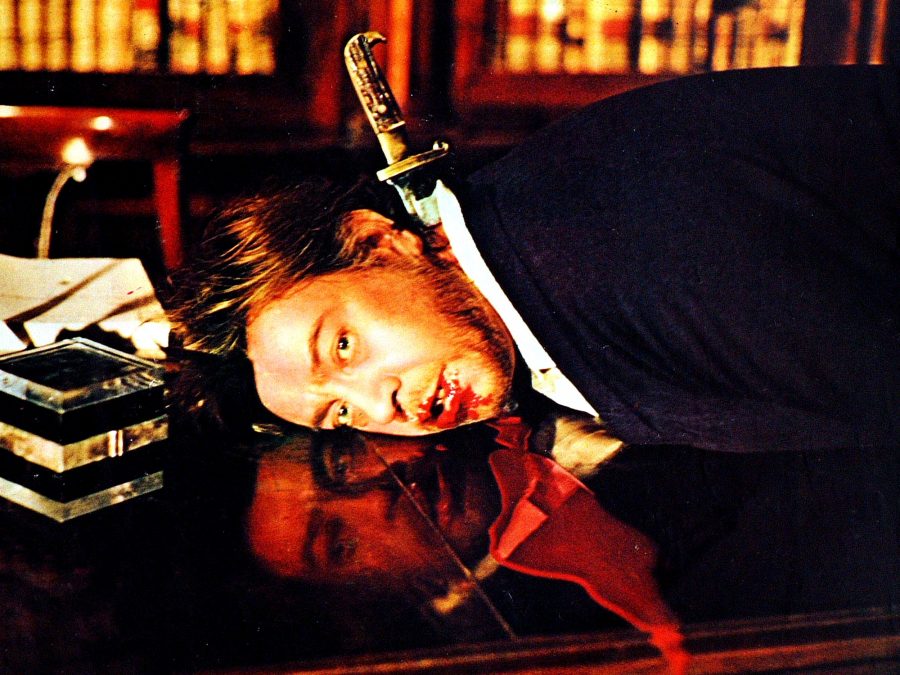A sweet children’s song, a Christmas tree in a cosy domestic setting, silhouettes on the wall showing one person viciously stabbing another, and then a blood-stained knife falling to the floor, by the shoes of a standing child. This is the prologue to Dario Argento’s Deep Red, and also its primal scene – the source of a trauma that keeps resurfacing over a decade later. It is also a piece of shadow play in the theatre of a disturbed mind, leading us to draw certain connections and inferences, while being open to more than one interpretation.
Indeed, much of Deep Red will involve the discussion and reading of minds and art. “Really, that’s good, very good,” pianist and music teacher Marcus Daly (David Hemmings) tells jazz band in the present scene that immediately follows the past prologue. “Maybe a bit too good. Too clean, yes, too precise. Too… formal. It should be more trashy.” Here Argento may as well be laying out the aesthetics of his own film, which comes meticulously crafted, operatic even in its baroque mannerisms, but which is nonetheless aiming low.
For the director is still working within the trashy sensationalism of the giallo genre in which he had already established his name and signature style with the ‘animal’ trilogy The Bird With the Crystal Plumage, The Cat O’ Nine Tails and Four Flies on Grey Velvet. Deep Red was originally intended to belong to this series, and its working title was the more bestial-sounding The Sabre-Toothed Tiger. But even if the film was briefly rereleased in America during the early ’80s as The Hatchet Murders, Deep Red eventually stuck.
After recognising that there is a “twisted mind” with “perverted, murderous thoughts” in her audience, Lithuanian telepath Helga Ulmann (Macha Méril) is later killed in her apartment. Her screams draw Marcus, her upstairs neighbour, to the scene, but he is too late. When questioned by the police he becomes convinced that one of the macabre pictures he saw in passing on Helga’s walls is now mysteriously missing. “Maybe,” fellow pianist Carlo Manganiello (Gabriele Lavia) suggests to Marcus, “that painting was made to disappear because it represented something important.” Yet as Marcus tries to remember, the mysterious killer wants a past crime to remain forgotten, and commits many more murders to cover a bloody trail leading all the way back to the primal scene.
It is not just a painting that must be found, but a supposedly haunted house, and a missing window (with a missing room behind it), and various infantile reproductions (whether on paper or fresco) of that first killing, all to piece together the identity of the killer. Barely helped by the incompetent police, Marcus reluctantly joins forces with ambitious journalist Gianna Brezzi (Daria Nicolodi), and as they become both investigative partners and lovers, the chauvinistic pianist learns the price of underestimating women. Much of this couple’s relationship was excised by Argento himself for the film’s original 100-minute theatrical version, but has been reinstated for a 126-minute edit whose additional scenes have never been dubbed into English.

It is well worth watching them. For while these scenes’ comic tone may sit oddly with the rest of the film, there is something about the sight of Marcus sunk into the broken passenger seat of Gianna’s barely functioning little car, that perfectly encapsulates the folly in Marcus’s posturing masculine superiority. Here it is Gianna who is both positioned above her male passenger, and very much in the driver’s seat – and from this a more general lesson can be drawn about the film’s inversion of gender norms, at least according to the sexist Marcus. “Men and women are different,” he will tell Gianna, “Women are delicate, fragile.” Yet the film will repeatedly challenge his assumptions and prejudices about woman’s capabilities.
Deep Red was a transitional film in Argento’s career, bridging the gap between his earlier gialli and his later leanings towards the supernatural in features like Suspiria, Inferno and Phenomena. Indeed, much as Helga has the uncanny ability to read minds, in one scene here, her colleague Professor Giordani (Glauco Mauri) describes the telepathic powers of insects, and in so doing, practically predicts a key point of Phenomena’s plotting, a good decade before it was made. All the grotesquely bloody murders of Argento’s previous detective stories are here present and correct, while this is the first in a long musical collaboration with Italian prog rockers Goblin and their front man Claudio Simonetti.
As both Marco and the killer try to reconstruct the primal scene in their different ways – the one to solve a crime, the other to recreate its circumstances – Argento pulls off a genuine coup de cinéma by revealing the killer’s face remarkably early in the film, but in such a way that if you do not know what you are looking for, you will not see it, even though Argento plays entirely fair in the relevant sequence and the face is most certainly there. This film is very good, but also distinctly trashy, as the elegant art gallery in a Helga’s home hides a cleaver-wielding presence determined to paint and repaint everything deep red.
Deep Red is released on Limited Edition 4K UHD Blu-ray, DVD and soundtrack CD from 25 October via Arrow Film.
The post Why Dario Argento’s Deep Red remains a trashy masterpiece appeared first on Little White Lies.
![Forest Essentials [CPV] WW](https://s3-us-west-2.amazonaws.com/pcw-uploads/logos/forest-essentials-promo-codes-coupons.png)
0 comments